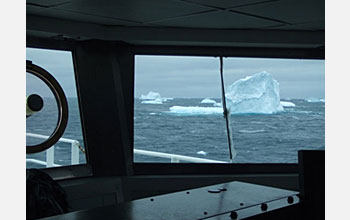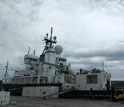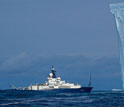|

Discovery
For Better or Worse, Modern Ocean Explorers Stay Connected

Improvements in shipboard communications mean scientists can keep in constant touch, even when their research takes them to remote locations
April 28, 2008
On a six-week business trip in the winter of 2007, Cassandra Lopez posted updates to her friends on Facebook and conversed with her family on Gmail chat. What made these interactions unique was that Cassandra was on-location in the Southern Ocean, writing oceanography articles from one of the world's most remote places. The 24/7 Internet access on research vessels attracts a new type of oceanographer--those who want to get away from it all, but also blog about it. Cassandra was aboard the research vessel R/V Roger Revelle of the Scripps Institution of Oceanography (SIO) at the University of California-San Diego in La Jolla, Calif. Like most large ships of its generation, the R/V Roger Revelle comes with advanced communication systems, as well as crew members devoted to technical support. The satellite system on the R/V Roger Revelle enables the ship to better serve as a laboratory for scientific research by providing constant Internet access. The system also has the byproduct of helping seagoing researchers and crew members maintain relationships back home. On top of a fairly consistent e-mail service, several crew members maintain blogs to tell friends and family about their shipboard experiences. Joe Ferris, a second mate, recently posted on travel plans, piracy evasion, navigation and working out. Resident technician Dave Langner takes advantage of the real-time camera system, which uploads snapshots from the ship to a San Diego database every10 minutes, to keep in touch with his mother. "Sometimes I'll e-mail her just before I go on deck," he says, "and she can see me working from her computer screen." Veterans of ship life say that communication has improved dramatically in the past two decades. Acoustics specialist Jules Hummon recalls that when she first started going to sea in 1988, images were faxed via satellite-linked modems, and the devices took half an hour to transmit a page-long image of sea surface temperatures. On her first trip, she was billed by the kilobyte for two personal faxes--a letter from her mother and a "Calvin and Hobbes" comic strip from her husband. They cost her over $100 to receive. These days, she can download reasonably sized images through e-mail, using the HiSeasNet satellite connection at no additional cost. These improvements have come about as a result of two innovative, long-term projects based at the SIO and funded by the National Science Foundation (NSF), the Office of Naval Research and universities in the Joint Oceanographic Institutions: HiSeasNet, which has built an infrastructure to provide constant high-speed Internet to research vessels via satellite, and the ROADNet, an accompanying network that makes images and sensor data available to anybody with Internet access as it is being collected. Still, the ability to stay connected to land is a mixed blessing for oceanographers, who appreciate the relative simplicity of life at sea. In a survey taken of scientists and crew members on the R/V Revelle's CLIVAR I8S expedition last March, most respondents echoed the sentiment of chief scientist Jim Swift, who listed "getting away from the distractions of professional life" as one of ship time's primary appeals. Chris Measures, a trace metals scientist and oceanography professor, finds that better communication has increased his responsibilities at sea. Besides being constantly on-call for the six weeks of CLIVAR I8S, he was in charge of coordinating a grant proposal with researchers in the United States, India and Italy, which he submitted by shipboard e-mail. The improved capacity for communication has also brought the interruptions of personal life. Seagoers fret about termite infestations and errors in bills and pet sicknesses that they can do nothing about, barring their physical presence. Furthermore, the inconsistency of satellite connections makes it difficult to have relationships with those onshore, as the expectations of communication are hard to fulfill. On a four-week trip off the coast of Indonesia, resident technician Dave Langner wondered if a relationship was floundering. "She hadn't responded to some important e-mails I had sent," he said. "It turns out she just hadn't received them." Second mate Joe Ferris, who spends five to seven months at sea every year, doesn't bother: "I only date when I'm not working," he says. The oceanographer tends to fall on the adventurous end of the personality spectrum, but the demands of the ocean-going lifestyle remain at odds with the standard urge to settle down, some have found. After more than a decade of traveling out of a ship's berth to exotic locales, Ferris is thinking seriously about buying property and moving his things out of storage. Few give it up completely, but many cut down in their ship time as they move into the patterns of a more stable life--buying homes, finding partners, having children. Lynne Talley, a professor and researcher at the SIO, spent much of the 1990s at sea, but she now devotes her time to teaching and writing on campus to stay closer to her family. Frequent e-mailing may not fully substitute for being at home, but it is remarkable that shipboard communications have evolved such that new oceanographers can compare sea time to business trips made by their friends in marketing and consulting. "Many careers require travel," says Cliff Buck, a graduate student at Florida State University. "I don't really see this lifestyle as being all that unusual." -- Pien Huang, Scripps Institution of Oceanography at UC San Diego pien.huang@gmail.com This Behind the Scenes article was provided to LiveScience in partnership with the National Science Foundation.
Investigators
Jim Swift
Jules Hummon
Chris Measures
Related Institutions/Organizations
University of California-San Diego Scripps Inst of Oceanography
Locations
California
Antarctica
New Zealand
Related Awards
#0612725 Oceanographic Technical Services 2006 - 2008, R/Vs Revelle, Melville, New Horizon and Sproul
#0504624 Ship Operations-R/V Roger Revelle
Related Agencies
Office of Naval Research
Related Websites
LiveScience.com: Behind the Scenes: For Better or Worse, Modern Ocean Explorers Stay Connected: /news/longurl.cfm?id=62
LiveScience Image Gallery: Extreme Living: Scientists at the End of the Earth: /news/longurl.cfm?id=31
|





